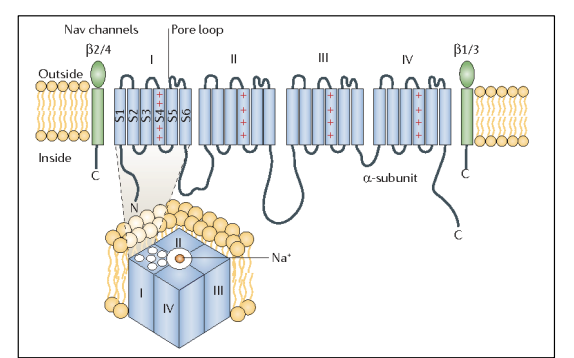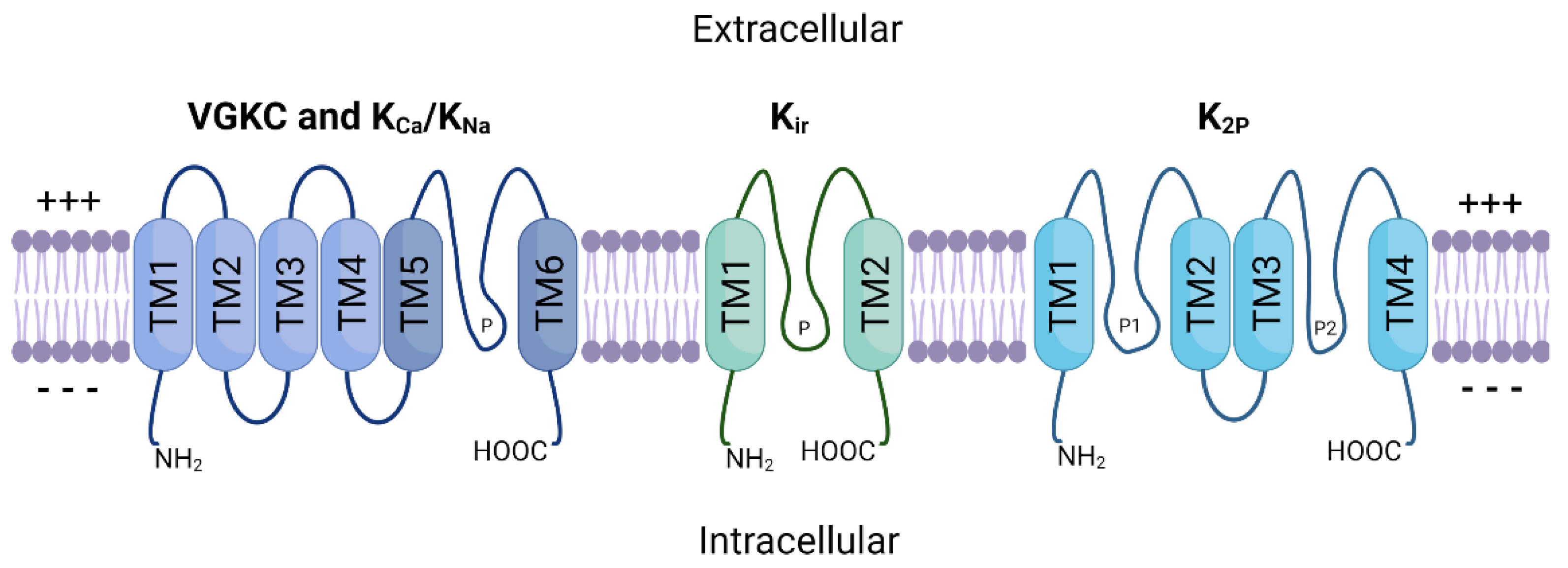L2: Voltage gated ion channels ADD ppt!
1/66
There's no tags or description
Looks like no tags are added yet.
Name | Mastery | Learn | Test | Matching | Spaced |
|---|
No study sessions yet.
67 Terms
what are ion channels
membrane-spanning proteins
with aqueous solution in a central pore
How do they open and close (gating)
conformational changes of protein strucutre
within the plasma membrane
rapidly flux ions
Hodgkin and Huxley did what
showed the squif giant axon generates the action potential waveform
using only two types of voltage-dependent conductance
Na+ and K+
used the voltage-clamp method
Voltage-clamp method
uses a differential amplifier
to inject a currnet into the cell
in order to counteract any differeence between the voltages of its two inputs
The measured cell membrane potential
command potential
Why is this way useful?
current necessary t maintain the cell membrane at a precise value is generated by
the circuit
and
this can be measured
When it is measured, it shows that…
it is equal and opposite to the current flowing across the membrane
How did researches get to understand the strucuture of ion channel proteins:
sequence the DNA encoding the primary amino acid sequence of ion channel proteins
using recombinant DNA technology
exmaples:
HYdropathy analysis
mRNA things?
What did hydropathy analysis do?
determines the hydrophobivity of the amino acids
allowed putative transmembrane sequences to be identifed
enabling the prediction of the secondary strucutre of the polypeptide chain
i.e which parts were in the membrane and which parts were in the extracellular and intracellular space
What to do next?
Make models:
developed of tertiary and quaternary arrangements of the channels
their accessory subunits in the membrane
what techniques has 3D strucutre been elucidated by
high-resolution electron microsopy
electron and X-ray diffraction
Once an ion channel DNA sequence was identified, mRNA can be…
mRNA made
injected into expression systems e.g Xenopus oocyte or mammalian cell lines
causing it to be expressed in the cell membrane
properties of the cloned channel were investigated using electrophysiology
How are the cloned channels investigated using electrophysiology
use two-electrode voltage clamp (in oocytes) of macroscopic currents
or
patch-clamp recordings of single channel and whole cell currents in cell lines
What do site-directed mutagenesis help do?
site-directed mutagenesis applied to change individual amino acid residues
in regions thought to be functionally important
Ionic conductances underlying the action potential: in the squid giant axon
a depolarisating voltage change from rest (-65mV) to 0mV
caused by an early fraction of current carried by inward movement of Na+ ions (Na+ conductance)
What happened if Na+ was reduced?
this depolarising voltage change disappeared
If the voltage step is maintained
It activates then inactivates
over several ms
A later fraction of current is carried by…
outward movement of K+ ions (K+ conductance)
What does this do?
activates more slowly than Na+ current
however, with maintained depolarisation
does not inactivate
On repolarization
it deactivates
What do the size of the Na+ and K+ currents depend on
the size of the voltage step
the IV relationship
What did H&H find
they could describe the time course of the Na+ and K+ conductances
The full model of the action potential
which incorporates the resting leak conductances
Can be expressed in a differential equation for the voltage across a patch of membrane
What is this equation called
Hodgkin-Huxley equation
By solving equation, H&H were able to
reproduce action potential waveforms of exactly the right shape
this was significant because thei on channel strucutre has not been eluciated and recordings of current through single ion channels not yet been possible
Voltage-gated ion channels (VGIC) are gated by…
changes in membrane potential (voltage)
When open, VGICs tend to be
highly selective for a particular ionic species
named for this permeabbility:
Voltage-gated Na+ channels (Nav)
Voltage-gated K+ channels (Kv)
Voltage-gated Na+ channels (Nav): how identified and studied
partially purified from electric ell
with aid from puffer fish selective toxin (tetrodotoxin TTX)
Messenger RNA was then used to make complementary DNA libraries
cDNA clone encoding the electric eel voltage-gated Na+ channel (Nav) was isolated
Voltage-gated Na+ channels (Nav): What was found out about the strucutre of the channel
single large (260 kDa) pore-forming peptide of 1832 amino acids→ alpha subunit
Nav: isolation of the primary amino acid sequence meant predictions could be made about the stucture of the channel…
Hydropathy analysis
4 similar domains (I-IV) each composed of 6 transmembrane (TM;hydrophobic) segments, S1-6
Nav: the initial proposed secondary strucuture
needs to incorporate intracellular N- and C-termini
includes:
a pore loop between S5 and S6
believed to line the entry to the pore
with S5 and S6 forming the remainder of the pore
S4
Although sufficiently hydrophobic to be membrane spanning
charged amino acids were also noted
S4 initially placed in the cytoplasma

Nav, but where is S4 now thought to be?
thought to be trans-membrane TM
forms a voltge sensor

Nav how many S4 voltage sensors are there per channel?
4

Nav: upon depolarisation, S4 helix…
changes its conformation in the membrane
represents activation
Nav: alpha subunit in different tissues
have many different isoforms
brain→ Nav 1.1-1.3
preipheral nervous system (Nav1.6-1.9)
skeletal muscle (Nav1.4)
cardiac muscle (Nav 1.5)
however:
their properties are similar
Nav: what does an associated auxillary beta subunit do?
modified key properties of the channel
Voltage-gated K+ channels (Kv)
part of the larger family of potassium channels
also includes partially voltage-sensitive K+ channels and voltage-insensitive K+ channels
Why were voltage-gated K+ channels types named what they are
according to their properties
delayed rectifiers, inward rectifiers, A-tpyse
However, with out better understanding we now know that…
different functional properties can arise from various combinations of subunits
→ it is perhaps better to view voltage-gated K+ channels from a subunit perspective…
The many alpha subunits
Kv1-Kv12
Although, 4 families…
Kv1,Kv2,Kv3,Kv4)→ form the core voltage-gated K+ channels
Classical ‘delayed rectifer’ K_ channels are formed by…
e.g the slowly sctivating Kv in the squid giant axon
Kv1, Kv2, Kv3 and Kv4 families in mammalian neurons
each family contains several subtypes
What are A-type K+ channels formed from
Kv4 proteins

The very first K+ channel gene isolation…
Drosphophila nad called ‘Shaker’ gene
wildtype Drosophila will shake when exposed to 4-aminopyridine (4-AP)
a drug that blocks A-type K+ current
mutant drosophila line shakes under normal conditions in a similar way to wildtype flies under 4-AP conditions
This lead to the idea that ‘Shaker’ mutant might have a mutation…
in a K+ channel
because that is what 4-AP blocks
This is correct:
Shaker flies do not have a normal A-type K+ currents
Researchers took advantage of this and…
isolated the DNA for the mutant’Shaker’ Kv in 1987
→ provided the first amino acid sequence for a voltage-gated K+ channel
Kv channel strucutre
forms from 4 alpha subunits
each hoomologous to one domain of a much larger Na+ channel alpha subunit
form tetramers of alpha subunits (along with auxiliary subunits)

Kv alpha subunits are described as
6TM proteins
each alpha subunit has the S1-S6 transmembrane segments
including S4 coltage sensor
and a pore loop
as seen in Nav channels
THEREFORE: each voltage-gated K+ channel would have 4 S4 segments for voltage sensing
Structurally related K+ channel family members include…
Calcium-activated K+ channel (Kca)
similar membrane topology to Kv channels
but sytoplasmic doomain has calcium-binding sites which mediate gating
in addition to voltage-gating in some Kca subtypes)
KIR channels are strongly inwardly-rectifying channels
as a result of intracellular polyamine and magnesium block
have different topology:
tetramers of subunits, but
each subunit has only two membrane-spanning segments (2TM)
analagous to S5 and S6, with the pore loop between
‘Two pore domain’ K+ channels (K2P)
have 4 TM domains
2 pore loops
essentially, two units of the 2TM channels
usually open, not gated by voltage
contribute to the resting membrane potential
K+ channel and information coding?
little information can be coded in the size of the axon potential
continuous depolarising current at the axon initial segment
repeated action potentials are fired
The bigger the current…
the higher the frequency of the action potentials
‘spike frequency coding’
'Frequency and pattern of action potential firing is influenced by…
types of voltage-gated ion channels expressed in the axon
Example 1→ ‘delayed rectifier’ K+
conductance activates relatively slowly
shows little inactivation
compared to…..
Example 2→ ‘A-type K+ conductance
activates and then inactivates relatively rapidly
and required hyperpolarization to relieve inactivation
Other voltage-gated K+ conductanecs …
keep the action potential waveform narrow enough
to allow repetitive action potential firing
at very high frequencies
Certain voltage-gated K+ channels activate at…
relatively hyperpolarised membrane potentials
are very effective ‘brakes’ on excitability
Membrane depolarisation during the action potential rising phase can…
activate voltage-gated Ca2+ conductances resulting in
Ca2+ ion influx
activation of calcium-dependent K+ conductances
Large calcium-activated K+ conductance (BK) contributes to…
Repolarisation
→ Making the action potential width narrower
Small calcium-activated K+ current (SK) contributes…
to longer-lasting after-hyperpolarisation (AHP)
→ broadens the action potential
slows the firing frequency
can help to keep the firing pattern regular
Strucuture-function studies of VGICs:
Inactivation
Selectivity filter
Strucuture-function studies of VGICs: Inavtication
suggested that the cause of Na+ channel inactivation was the N-terminal intracellular region of the ion channel protein
→ ‘ball and chain’ to block pore
another paper: critical sequence N-terminal amino acids
when mutated→ disrupt inactivation in Drosophila ‘A-type’ K+ channels
Selectivity filter: what determineds which ions can permeate
size of the pore
charges of amino acid groups in the pore
perhaps some other things (water)…
Although K+ is larger than Na+, how do channels allow K+ in but not Na+ by a factor of more than 1000?
mutations of amino acids in the pore loop between S5 and S6 altered ion permeation and ‘open channel block’
by the drug, TEA
What did this suggest?
the pore loop contributes to the selectivity filter
in the outer (extracellular) part of the pore
MacKinnon published X-ray crystal strucutre of bacterial K+ channel (not voltage gated but selectively permeable):
2TM spanning regions
analagous to S5 and S6 in a 6TM Kv
shaker mutations that affect ion selectivity were mapped onto the crystal strucutre of the pore
The ion selectivity filter was deduced to be…
short, narrow segment bind a dehydrated K+ ion
effectitly mimic the hydration shell of the hydrated K+ ions in the rest of the pore
Why does this allow K+ in but not Na+?
K+ ions are close to eachother in the region of the pore
repel eachother and facilitate the passage of a line of K+ ions though the selectivity filter
into the cental region of the pore
Amino acids i the channel signature sequence are unable to bind a dehydrated Na+ ion
This signature sequence is…
highly conserved amongst different K+ channels